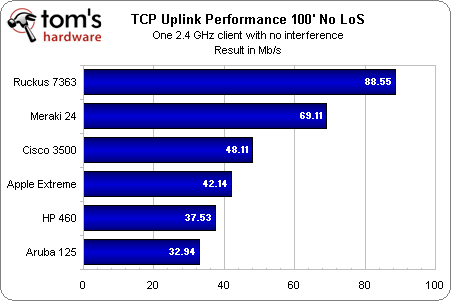Why Your Wi-Fi Sucks And How It Can Be Helped, Part 2
In Part 1, we explained what can go wrong with Wi-Fi signals and how access points can work to improve your wireless performance. It's time for a reality check. We throw six contenders against 65 clients and some hellish interference. Who's left standing?
Long-Range, No Interference
We wanted to test our five access points under worst-case conditions, which is where our 100-foot, non-line-of-sight test comes in. We also used this test to switch everything over to 2.4 GHz—again, in search of a worst-case scenario.
Without interference, Meraki rejoins the race and performs very well, perhaps somehow managing to bring all three of its streams to bear on the distance and obstructions. HP can’t match its counterpart and falls to the middle of the pack. Apple brings up the rear at 27 Mb/s, but this is still quite respectable for a consumer product under such conditions.
The story stays much the same on the uplink side. Interestingly, Aruba drops to last, while Apple moves up into fourth place. Meraki again performs very well, and Ruckus makes long distance look easy.
Throughout testing, we wondered about the factors underlying some of the performance differences between products. In particular, we wondered why Cisco consistently outperformed two-stream peers Aruba and Apple. Answers remained elusive, of course, but quality control at the board level can vary considerably between access points—and Cisco is well-known for having excellent in-house (as opposed to outsourced) engineering and quality control.
For example, if on-board wires aren’t engineered to have exactly the same electrical impedance, there will be a little energy loss with each connection. RF reflection and noise inside the circuit board can also weaken performance. A very well-engineered AP will minimize or eliminate such factors.
Get Tom's Hardware's best news and in-depth reviews, straight to your inbox.
Current page: Long-Range, No Interference
Prev Page Benchmark Results: Mid-Range, 1 Versus 60 Clients Next Page Long-Range, 1 Versus 60 Clients Plus Noise
